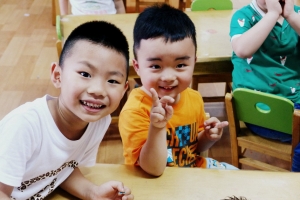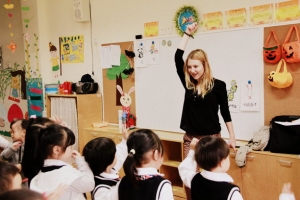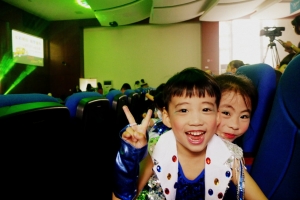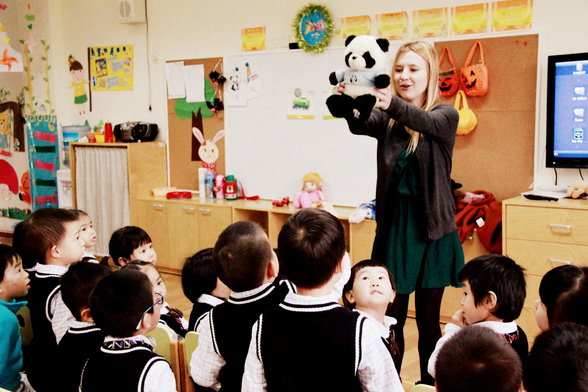By Fabienne King (Teacher in Suzhou 2015-2016)
During my training in Beijing I taught some lovely secondary school students, whose articulate English-language letters I still had in my pockets as I reached my new school – A Kindergarten in Suzhou, in the Jiangsu Province of China. From teaching and conversing with teenagers on topics such as ‘dubbing’ in film, the pros and cons of technology and freestyle football, I had to go back to basics and teach the alphabet. Although both ages were wonderful to work with it was a learning curve to adapt to meet the needs of Kindergarten and Grade 1 students after my training with older pupils. The year that followed involved lots of singing, dancing and games as I developed my teaching style to suit younger learners.
A different classroom environment
The Kindergarten I worked at was bright and full of surprises with toys and turtles and tadpoles to be found in every corner. There were playrooms and classrooms with beds so that the students could have their scheduled post-lunch nap, and lunch was brought to the classrooms (rather than students eating in the canteen) due to the students young age.
Each class room had a projector and TV which I could plug my USB stick into, and I was given text books for each grade with about two weeks to cover each topic, with time for review. While I examined my primary school grade 1 students, and foreign teachers at secondary school often set exams for pupils, there were no formal examinations in Kindergarten. What resources you have available will depend greatly on your school, but my school was well-equipped and despite the suggested topics, I was given a long time to cover material. This allowed me to play lots of games or even cover additional topics of my choosing. The topics are notably a lot simpler than for older students, with a focus on colours, animals and learning basic sentences.
Teaching Kindergarten is also a lot more pastoral than teaching older students – as mentioned, my pupils had naps and drink-breaks. They needed hugs and would cry at the drop of a hat – if they lost a game, didn’t understand something, missed their mum or accidentally chose a princess sticker when they realised they could have had buzz-light year.
Mixed Abilities in Kindergarten
The Kindergarten where I taught was split into three grades, of which I taught all of the students – low, middle and high classes. I also taught additional BOYA classes which were essentially extra private lessons for paying students. All of my classes differed in length and age group, and I taught some classes more than once a week so planning for each class was still important despite the students’ young age. Students are developing so much at this age that the difference between my oldest and youngest Kindergarten students was very obvious.

Low Classes – These were my youngest students who were 4 or 5 years old. Kindergarten students have a very short attention span so Low Classes were normally only 20 minutes long and even then I found I needed three or four different activities in each class to keep students engaged. This is very different to teaching older students as largely Kindergarten cannot be left unsupervised or to work independently. My low classes were too young to draw or write by themselves, so at stretch they could be given colouring sheets and templates. Typical tasks for older students like preparing presentations, posters, writing content or filling in worksheets were mostly avoided and replaced with simple games, flashcards and songs.
Middle Classes – These students were a little bit older, though not yet ready for grade one. They had the most variation in ability, and I covered topics like counting to ten, prepositions (in, out, in, out and shake it all about!) and seasons. Content is repeated and added to across Kindergarten so a topic like the weather is revised at all levels but with new and more exciting words or sentence structures developed. My middle class students and high classes were also invited to do additional BOYA classes (lasting one hour) so it was at this age that you noticed differences in ability. Some students were at a guided basic one-word/simple sentence stage still, while others could independently think of sentences. (Teacher… you like
High Classes – My oldest Kindergarten students, many of whom could attempt to talk to me in simple sentences or at least get their point across, were quite capable of asking to watch Mr Bean (Hān dòu) ‘one more time!’ and changing the course of my lesson plan. While not as easily entertained by simply holding up a real apple, they could play more advanced games and enjoyed competition with their peers more than younger students. A lot more boisterous, these students were 7 years old and learning more advanced words like ‘post office’, ‘octopus’ and ‘scarf’ and on occasion were likely to giggle at my poorly-pronounced Chinese.
When I first arrived I was surprised by how much the Kindergarten could still do, and how many games, with slow explanation and help from a Chinese Teaching Assistant I could explain to them. They were bouncy, excited kids and many games could be adapted to suit all different levels of Kindergarten.
Back to Basics – Activities for Kindergarten
Moving Around
Learning for young children is very focused around play and sensory activities. Methods involving TPR (Total Physical Response) work really well as children are quick to associate movements with words and are far less self-conscious than older students. Wherever possible I would try and use hand gestures to emphasise what I was saying, and I would invent actions to go with songs which didn’t already have them. ‘Head, Shoulders, Knees and Toes’ and ‘One Little Finger’ were fantastic for teaching body parts. When I taught ‘family members’ I had my students do particular actions whenever I held up a certain flashcard (A bit like the game Captain’s Coming!). For example, when I shouted ‘grandma’ my students had to hobble around the room pretending to have a walking stick.
Games like Teacher Says (Simon Says) were fantastic and as my students improved, I stopped doing the action with them. This could be done with a variety of verbs, (swim, fly, jump,) and I also played it to recap body parts (touch your toes, touch your head). Another variation of Teacher Says I found really great, was replacing the description as ‘I can [–jump]’ or ‘I can’t’ and having student’s behave accordingly. This meant they had to listen to subtle sound differences as well as understand the vocabulary.
While moving around is generally really engaging for students, I did find that I had problems sometimes here with classroom control. Attempting to teach a High Class how to do the Cha Cha Slide resulted in utter chaos, and I had to change it to allow only one or two students to stand up at once and jump (which they still found incredibly exciting). Games like ‘Do as I say not as I do’ were also fantastic as I had students come up to the front of the class and challenge the teacher one at a time. This way, a class of 30 students was a lot easier to manage.
Flashcards and Realia (real items)
Alongside singing songs, flashcards were the bread and butter of Kindergarten life. I replaced flashcards when I could with real items (toy cars, apples and dolls) and they were the visual basis of many lessons. At such an early level often students are encouraged just to learn individual words or simple sentences (I like../I have a…) (cat, dog, watermelon) so flashcards are good for both introducing and reviewing content quickly. At the most basic level, I would hold up a flashcard and ask students ‘What’s this?’, but this could be developed into all sorts of games such as Tic Tac Toe, What’s Missing and the ever popular Flashcard Race. One of my most successful classes involved playing the ‘Clothes Song by Peter Weatherall’, and scattering clothes flashcards around the room. I would then bring out some string and pegs to make a makeshift washing line, and ask students to ‘find the tshirt’ and pin it on the line. Often with Kindergarten, I found that simple uncomplicated games are the best.

Songs
Any worries about my singing voice had to be quickly overcome as a Kindergarten teacher. Songs were always successful and soon the whole class was dancing around to the banana sandwich song, and I was often handed a microphone in whole grade assemblies, particularly if equipment failed. I found lots of great songs with videos for young learners on YouTube and also the Chinese equivalent Youku. I downloaded these, so I could bring them into class on a USB stick. Songs with videos were very popular as I could pass songs onto my Chinese colleagues and playing songs (particularly with videos) was the best way to calm a noisy, distracted class down. Without fail, turning on the TV would have my scattered, distracted students suddenly silent and transfixed on the screen. Songs can be played over and over again, and often I would have students hold up flashcards when they, for example, recognised the animal on the screen with the one they were holding. I found this was a good way to also assess whether my youngest students were understanding target vocabulary. I found my students could understand what they were hearing a lot faster than they could express themselves independently so at an early level matching or pointing out images silently worked well to assess knowledge. Students have favourite songs, and after listening to a song once, I would encourage the students to participate more with the song, whether through actions or flashcards or play. Songs are great because students can participate more or less with them depending on ability meaning all level of students can gain something from them. They are versatile because they can both teach content and are perfect fillers if you have an extra five minutes. I think one of my favourite Kindergarten moments was having my class break into song during the chorus of ‘Let it go’, or to walk past my students only to find them quietly singing in English to themselves whilst colouring.
Stories
Similarly to songs I used stories to introduce new content – though these had to be very simple. Mr Bean (Hān dòu) was extremely popular both with students and Chinese teachers and I often used this, along with stickers, as a reward. I also planned lessons around Goldilocks and The Very Hungry Caterpillar, often to review content with my older students. Peppa Pig was also popular and could be found online in short 5 minute clips. As a general rule, I found that videos worked really well, but only if activities were then based around them, particularly with more challenging videos. I had students perform Goldilocks, and did various sequencing activities based on The Very Hungry Caterpillar. Whilst on occasion I used a book to tell a story, I found this less effective because without as many pictures and with a larger class size, students could not follow very well. I think this would work much better with individual students or in smaller groups, particularly whilst the students are still so young.
Classroom Management – Dealing with Kindergarten difficulties
Unlike with older students, individual Kindergarten tantrums are more frequently and obviously related to biological issues – is a pupil tired? Hungry? Too hot? As a general rule, when a lesson wasn’t going to plan I found re-evaluating my own behaviour to be the first point of call. Was I speaking too fast and using too difficult vocabulary? If students found the work too difficult they became frustrated or bored as they simply did not understand and therefore couldn’t engage. Sometimes a lesson was simply boring. Or, as I also found at times, simply too exciting. Having all my students running around playing ‘Wolf, Wolf What’s the Time?’ seemed like a good idea. But with my youngest students, in a medium sized classroom, this simply resulted in a pile up of giggling, confused and over-excited children.
I found I did not have to use many punishments in Kindergarten, and students are too young for detention or extra homework. Often I would ask my Chinese Teaching Assistant to talk to students who were misbehaving and this would be enough, as I could generally then identify the issue. I definitely used basic Chinese alongside English to make my classes run more smoothly and it’s always good to prepare for the unexpected. Equipment might not work, or at times my TA could not translate for me or was otherwise engaged. A child might throw up. Young students are less empathetic and aware of other students so more likely to step on each other’s toes. Occasionally I moved students away from each other or asked them to sit on their own, but generally I found rewards worked much better to motivate and encourage good behaviour. Students loved exciting stickers and games, and sometimes having these denied or promised was encouragement enough. Reprimands tended to be short and I tried to make my classes fun and positive. When I first started teaching I remember being terrified of a noisy class, fearing that Chinese Teachers might think I wasn’t in control and I felt uncertain about my teaching style as a young, new teacher. However, I quickly realised that contained noise and chatter was better, because it meant my students were engaged and enjoying the class. If they were talking, especially in English, then I was doing my job well and my TA’s were supportive rather than critical in the classroom.
Ultimately with Kindergarten a little goes a long way, and if you are willing to jump around, smile and have fun your students will get excited about English. My time teaching in Kindergarden involved performing in dance shows and dressing up as the Easter Bunny, a princess and Santa. My students would greet me excitedly with shouts of ‘Yīngyǔ lǎoshī’ (English teacher) and rush to hug my knees. Earrings were met with delight and simple activities (pretending to be exaggeratedly happy, sad or angry) were met with fits of laughter. I learned a lot from my students, they were surprisingly perceptive at responding to my mood instinctively – becoming grumpier if I was, or picking up on my own energy. Kindergarten is high energy, but it’s rewarding and great fun. For me it was a year of singing, dancing, colouring and laughing!

Above: Waiting to go on Stage for Children’s Day Performance
Ready to take the ESL classroom by storm? Here’s more information on our program in China
Interested in considering other options? Through our other brand Impact Teaching, we offer teaching jobs in Vietnam, Thailand, Cambodia or Poland or send in an application.
Or, if you’re still not sure, drop us a message; we’re here to help.


Leave A Comment
You must be logged in to post a comment.